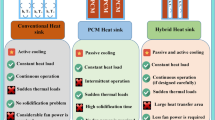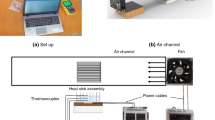Abstract
The development of small-sized electronic components requires the design of a small-sized heat sink, which limits the access to the high amount of heat transfer coefficient. In this paper, the use of phase change material is considered to overcome this issue. In this regard, a heat sink with and without the phase change material is numerically designed and the maximum temperature of the base plate is calculated and compared in two cases. The heat sink is assumed to be located on a base plate with different heat fluxes in the range of 2700–15,300 W/m2 and vicinity of a wide range of convective heat transfer coefficients from 1 to 550 W/(m2·K). Comparing the results between heat sink with the phase change material and without it indicates a certain amount of heat transfer coefficient, which, for less than that, the use of the phase change material reduces the base plate temperature, and over it, the phase change material raises the base plate temperature. Also, results show that the design heat transfer coefficient has an inverse relationship with the operating time of the heat sink, so that for long operating times, the use of PCM will be justifiable in the low heat transfer coefficients.












Similar content being viewed by others
Abbreviations
- HTC:
-
Heat transfer coefficient
- PCM:
-
Phase change material
- LHTS:
-
Latent heat thermal storage
- a :
-
Length of the heat sink, mm
- b :
-
Width of the heat sink, mm
- c :
-
Height of the heat sink, mm
- c p :
-
Heat capacity, J kg−1 K−1
- d:
-
Thickness of the base plate, mm
- f l :
-
Liquid fraction
- g :
-
Gravity acceleration, m s−2
- h :
-
Convective heat transfer coefficient
- H :
-
Enthalpy, J kg−1
- k :
-
Heat conductivity, W m−1 K−1
- n:
-
Normal direction to the boundary
- p:
-
Pressure, N m−2
- q " :
-
Heat flux, W m−2
- t :
-
Time, s
- T :
-
Temperature, \({}^{^\circ }C\)
- u:
-
X-velocity, m s−1
- v:
-
Y-velocity, m s−1
- w:
-
Z-velocity, m s−1
- \(\beta\) :
-
Volumetric thermal expansion coefficient, K−1
- \(\upsilon\) :
-
Kinematic viscosity, m2 s−1
- \(\rho\) :
-
Density, kg m−3
- Al:
-
Aluminum
- b:
-
Boundary
- d:
-
Design value
- eff:
-
Effective value
- l:
-
Liquid state/ Liquidus temperature
- latent:
-
Latent heat
- m:
-
Melting point
- max:
-
Maximum value
- ref:
-
Reference temperature
- s:
-
Solid state/ Solidus temperature
- sensible:
-
Sensible heat
- ∞ :
-
Air temperature
References
Arshad A, Ali HM, Ali M, Manzoor S (2017) Thermal performance of phase change material (PCM) based pin-finned heat sinks for electronics devices: effect of pin thickness and PCM volume fraction. Appl Therm Eng 112:143–155
Arshad A, Ali HM, khushnood, S. & Jabbal, M. (2018) Experimental investigation of PCM based round pin-fin heat sinks for thermal management of electronics: effect of pin-fin diameter. Int J Heat Mass Transf 117:861–872
Baby R, Balaji C (2014) Thermal performance of a PCM heat sink under different heat loads: an experimental study. Int J Therm Sci 79:240–249
Brent A, Voller VR, Reid K (1988) Enthalpy-porosity technique for modeling convection-diffusion phase change: application to the melting of a pure metal. Numer Heat Transfer Part A Appl 13:297–318
Cerimele M, Mansutti D, Pistella F (2002) Numerical modelling of liquid/solid phase transitions: analysis of a gallium melting test. Comput Fluids 31:437–451
Dhaidan NS, Khodadadi J, Al-Hattab TA, Al-Mashat SM (2013) Experimental and numerical investigation of melting of NePCM inside an annular container under a constant heat flux including the effect of eccentricity. Int J Heat Mass Transf 67:455–468
Faden M, Höhlein S, Wanner J, König-Haagen A, Bruggemann D (2019) Review of thermophysical property data of octadecane for phase-change studies. Materials 12:2974
Fan L-W, Xiao Y-Q, Zeng Y, Fang X, Wang X, Xu X, Yu Z-T, Hong R-H, Hu Y-C, Cen K-F (2013) Effects of melting temperature and the presence of internal fins on the performance of a phase change material (PCM)-based heat sink. Int J Therm Sci 70:114–126
Fok S, Shen W, Tan F (2010) Cooling of portable hand-held electronic devices using phase change materials in finned heat sinks. Int J Therm Sci 49:109–117
Gau, C. & Viskanta, R. 1986. Melting and solidification of a pure metal on a vertical wall.
Gopalan KS, Eswaran V (2016) Numerical investigation of thermal performance of PCM based heat sink using structured porous media as thermal conductivity enhancers. Int J Therm Sci 104:266–280
Hasan MI, Tbena HL (2018) Using of phase change materials to enhance the thermal performance of micro channel heat sink. Eng Sci Technol Int J 21:517–526
Hosseinizadeh S, Tan F, Moosania S (2011) Experimental and numerical studies on performance of PCM-based heat sink with different configurations of internal fins. Appl Therm Eng 31:3827–3838
Iten M, Liu S, Shukla A (2018) Experimental validation of an air-PCM storage unit comparing the effective heat capacity and enthalpy methods through CFD simulations. Energy 155:495–503
Kalbasi R, Salimpour MR (2015) Constructal design of phase change material enclosures used for cooling electronic devices. Appl Therm Eng 84:339–349
Kozak Y, Abramzon B, Ziskind G (2013) Experimental and numerical investigation of a hybrid PCM–air heat sink. Appl Therm Eng 59:142–152
Mahmoud S, Tang A, Toh C, Raya A-D, Soo SL (2013) Experimental investigation of inserts configurations and PCM type on the thermal performance of PCM based heat sinks. Appl Energy 112:1349–1356
Mosaffa A, Talati F, Rosen M, Tabrizi HB (2012) Approximate analytical model for PCM solidification in a rectangular finned container with convective cooling boundaries. Int Commun Heat Mass Transfer 39:318–324
Pakrouh R, Hosseini M, Ranjbar A, Bahrampoury R (2015) A numerical method for PCM-based pin fin heat sinks optimization. Energy Convers Manage 103:542–552
Sahoo SK, Das MK, Rath P (2016a) Application of TCE-PCM based heat sinks for cooling of electronic components: A review. Renew Sustain Energy Rev 59:550–582
Sahoo SK, Rath P, Das MK (2016b) Numerical study of phase change material based orthotropic heat sink for thermal management of electronics components. Int J Heat Mass Transf 103:855–867
Setoh G, Tan F, Fok S (2010) Experimental studies on the use of a phase change material for cooling mobile phones. Int Commun Heat Mass Transfer 37:1403–1410
Srikanth R, Balaji C (2017) Experimental investigation on the heat transfer performance of a PCM based pin fin heat sink with discrete heating. Int J Therm Sci 111:188–203
Wang X-Q, Yap C, Mujumdar AS (2008) A parametric study of phase change material (PCM)-based heat sinks. Int J Therm Sci 47:1055–1068
Wang Y-H, Yang Y-T (2011) Three-dimensional transient cooling simulations of a portable electronic device using PCM (phase change materials) in multi-fin heat sink. Energy 36:5214–5224
Author information
Authors and Affiliations
Corresponding author
Rights and permissions
About this article
Cite this article
Taghilou, M., Safavi, S.A. & Khodaei, M.E. Investigating the Effect of Heat Transfer Coefficient and the Heat Flux on the Thermal Performance of the PCM in the Heat Sink. Iran J Sci Technol Trans Mech Eng 46, 761–770 (2022). https://doi.org/10.1007/s40997-021-00479-5
Received:
Accepted:
Published:
Issue Date:
DOI: https://doi.org/10.1007/s40997-021-00479-5




